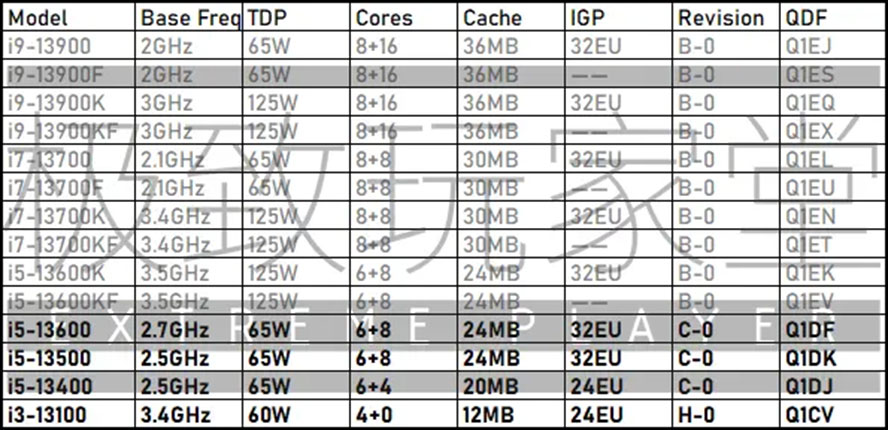
Our understanding of Intel's 13th-generation Core CPUs, codenamed "Raptor Lake," continues to take shape ahead of their planned launch this fall. Motherboards for current-gen Alder Lake chips have been adding preliminary support for them, and now a supposed list of the desktop CPU lineup (as reported by Tom's Hardware) suggests that Intel will be leaning on its CPUs' small efficiency cores (E-cores) for much of their performance gains.
Based on Intel's disclosures, we know that Raptor Lake CPUs will use the same CPU and GPU architectures and Intel 7 manufacturing process as Alder Lake. Its large performance cores (P-cores) will be based on an architecture called "Raptor Cove," though technical documents don't distinguish between it and Alder Lake's "Golden Cove" cores. And the E-cores will be based on the same Atom-derived Gracemont architecture that Alder Lake uses. The big cores handle the heavy lifting and provide the best performance for games and other apps that benefit from good single-core performance, while the E-cores pitch in for lower-priority and background tasks plus workloads like CPU-based video encoding and rendering jobs that can engage all of your processor's cores at once. It's tough to make exact performance comparisons, but AnandTech's benchmarks of E-cores in isolation suggest that they are about as fast as a midrange 6th-gen Skylake CPU core most of the time.
Intel has also confirmed that some Raptor Lake chips will include up to 24 physical cores, spread out across eight P-cores and 16 E-cores. Alder Lake CPUs max out at eight E-cores, for a total of 16 physical cores.
This purported CPU list builds on that knowledge, suggesting that top-end Raptor Lake Core i9 CPUs will all include 16 E-cores, up from the current eight, and that Raptor Lake Core i7s will all have eight E-cores where Alder Lake i7s include either eight or four. Clusters of four or eight E-cores will also be coming to the entire Core i5 tier for the first time. Current-gen i5-12600 (non-K), 12500, and 12400 CPUs don't have any E-cores at all, while the i5-13600 and 13500 will reportedly include eight E-cores, and the i5-13400 will come with four. The only Raptor Lake chip with no E-cores is apparently the i3-13100, which remains a quad-core CPU with all P-cores.

The "add more cores" approach is in line with Intel's strategy for boosting performance in its 8th-, 9th-, and 10th-generation CPUs. These were all based on some version of the company's 2015-era Skylake architecture and 14 nm manufacturing process, but the company steadily added more cores to counter AMD's success with its Ryzen CPU lineup. Though Intel uses the same manufacturing process for Alder Lake and Raptor Lake, it becomes easier to make larger and faster chips in greater quantities as chip yields improve and the number of defects decreases.
The 13th-gen chips are listed at the same TDP levels as their 12th-gen counterparts, though the base CPU frequencies are down for every chip but the i3-13100. The Turbo Boost frequencies will likely be a bit higher than the 12th-gen CPUs, so Intel can still claim increased single-threaded performance. Still, when all cores are loaded down at once, they may not be able to run at Alder Lake's speeds and stay within Intel's default power envelope. As with Alder Lake, raising the power limits from Intel's defaults should dramatically increase performance for most of these chips at the cost of (sometimes disproportionately) higher power use and temperatures.
AMD's imminent Zen 4 CPU architecture will still use a more traditional design, with various numbers of identical "P-cores" (AMD doesn't call them that, but for consistency's sake, it's helpful to think of them that way). Early and extremely sketchy rumors suggest that Zen 5 could sport a hybrid design, with Zen 5 P-cores and E-cores based on a modified version of Zen 4, but AMD hasn't confirmed this, and we're not likely to get any official news about Zen 5 until next year at the earliest.
These hybrid CPU architectures have intermittently caused problems with older or obscure software, including some old games and test-taking software that, for one reason or another, interpret the presence of a second CPU architecture as the presence of a second physical computer. But as time goes on, these issues are being resolved via Windows patches and app updates, and at least some PCs will allow you to work around them in the short term by shutting the E-cores off.


3175x175(CURRENT).thumb.jpg.b05acc060982b36f5891ba728e6d953c.jpg)
Recommended Comments
Join the conversation
You can post now and register later. If you have an account, sign in now to post with your account.
Note: Your post will require moderator approval before it will be visible.